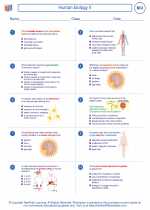Ultraviolet Waves
Ultraviolet (UV) waves are a type of electromagnetic radiation with shorter wavelengths and higher frequencies than visible light. They are invisible to the human eye but have various important effects on living organisms and materials.
Properties of Ultraviolet Waves
UV waves have wavelengths ranging from 10 nm to 400 nm. They are divided into three categories: UV-A (400-315 nm), UV-B (315-280 nm), and UV-C (280-100 nm). UV-C is the most energetic and harmful type, but it is largely absorbed by the Earth's atmosphere.
Effects of Ultraviolet Waves
UV waves have both beneficial and harmful effects. UV radiation is responsible for the formation of vitamin D in the skin, which is essential for calcium metabolism. However, overexposure to UV radiation can cause sunburn, skin aging, and an increased risk of skin cancer. Additionally, UV radiation can damage DNA, leading to mutations and potential health problems.
Applications of Ultraviolet Waves
UV waves have various applications in everyday life and industry. They are used in sterilization processes to kill bacteria and other microorganisms. UV radiation is also used in fluorescent lamps, tanning beds, and certain medical treatments.
Study Guide for Ultraviolet Waves
- Define ultraviolet waves and describe their position in the electromagnetic spectrum.
- Explain the differences between UV-A, UV-B, and UV-C waves in terms of their wavelengths and effects on living organisms.
- Discuss the beneficial and harmful effects of UV waves on human health.
- Describe the applications of ultraviolet waves in various industries and technologies.
- Compare and contrast the uses of UV radiation in sterilization and medical treatments.
- Discuss the role of UV radiation in the formation of vitamin D in the human body.
- Explain the mechanisms of UV-induced DNA damage and its potential consequences.
Studying ultraviolet waves provides insights into the interaction between electromagnetic radiation and living organisms, as well as its practical applications in various fields.
[Ultraviolet Waves] Related Worksheets and Study Guides:
.◂Biology Worksheets and Study Guides High School. Human biology II

 Worksheet/Answer key
Worksheet/Answer key
 Worksheet/Answer key
Worksheet/Answer key
 Vocabulary/Answer key
Vocabulary/Answer key
 Vocabulary/Answer key
Vocabulary/Answer key
 Vocabulary/Answer key
Vocabulary/Answer key
 Vocabulary/Answer key
Vocabulary/Answer key
 Vocabulary/Answer key
Vocabulary/Answer key
 Vocabulary/Answer key
Vocabulary/Answer key
 Vocabulary/Answer key
Vocabulary/Answer key
